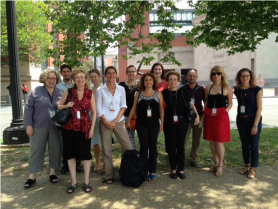About

This research project investigates trajectories of Jewish-gentile relations in Europe before, during and after WWII. Literature on the relation between Jews and gentiles during the Holocaust is rich. Following the example set by authors of classic works, most notably Raul Hilberg (Hilberg 1961, 1992), this relation is generally caught in the tripartite division of perpetrators, victims and bystanders. Although the problems attached to this ‘Bermuda-triangle of Holocaust-historiography’ (Bacon 2007) are recognized, the triad of perpetrators-victims-bystanders is still widely used to make sense of the complexity of inter-human relations during the Holocaust.
Moreover, it has long since been concluded that this tripartite division has been a crucial prerequisite for the Nazi-genocide as it facilitated segregation, discrimination and mass violence. Scholars acknowledge that the division was institutionalized during the war and was thus largely ‘German-made’, but their studies usually include prewar developments in Jewish-gentile interactions in order to highlight the proliferation of ‘home-grown’ anti-Semitism before the war. The much heard argument is that the supposed growing anti-Semitic climate of the 1920s and 1930s paved the way to further alienation between Jews and gentiles during the war and, eventually, the Holocaust. At the same time, tight connections to gentiles are considered to have been essential for the survival chances of Jews during the Holocaust.
Trending new fields of Holocaust-historiography have undeniably refined the image of Jewish-gentile relations. Important microstudies, like those of Jan Gross (2001), Nicolas Mariot and Claire Zalc (2010), and Mary Fullbrook (2012), have laid bare the intricate structure of small-scale communities. Zalc and Bruttmann (2012) propose a new microhistory of the Holocaust by adopting prosopographical approaches. Employing geographic methods in historical research, Jessica Rapson (2015) and the teams of Anne Kelly Knowles (2014) and Dieter Hecht (2015) have demonstrated the value of ‘mapping’. Jewish-gentile interactions and changes in these interactions become clear and highly visible by mapping places and spaces over time
These new studies show the benefits of microstudy. They point at the often porous line between perpetrators and bystanders and the dynamics of Jewish-gentile encounters, but their scope is generally geographically and temporally limited – mostly to the history of the Holocaust in one town. In order to discern larger, transnational patterns and to determine the impact of the Holocaust on relations between the people – Jews and non-Jews – involved, a wider framework both in time and place would be needed.
This research project builds upon the existing literature and the above described new historiographical trends, yet also claims to broaden the scale of analysis and to provide some correctives to generally held conceptions about Jewish-gentile relations. For a start, it departs from a different premise about the impact of prewar anti-Semitism. While intolerance and xenophobia were indeed expanding rapidly throughout Europe in the 1930s, not all Jewish-gentile relations seem to have been affected in the same way. Particularly in the modern European cities, where larger groups of acculturated Jews were engaged in firm networks with non-Jewish fellow citizens, the echo of anti-Semitism appeared to have been rather weak.
The focus of this project is precisely on these contacts: on the fabric of daily life of Jews and gentiles entangled in those networks that remained largely free from prewar anti-Semitic socialization. Following Rachel Brenner (Brenner 2014), we employ for these networks the term ‘emotional community’. This term has first been introduced into the historical discipline by medievalist Barbara Rosenwein in 2002. According to Rosenwein, emotional communities consist of networks of mental and emotional ties between people, like family ties, church memberships or neighborhoods: ‘the same as social communities […] but the researcher looking at them seeks above all to uncover systems of feeling: what these communities (and the individuals within them) define and assess as valuable or harmful to them; the evaluations that they make about others’ emotions; the nature of the affective bonds between people that they recognize; and the modes of emotional expression that they expect, encourage, tolerate, and deplore.’ (Rosenwein 2002)
Using the emotional community as our analytical framework enables us to look beyond the obvious social and professional ties, at the emotional tissue between Jews and gentiles. It can tell us more about identity and self-definition among community-members and about cohesive and adhesive forces affecting the communities. How did individual members – Jews and gentiles – react on consecutive anti-Jewish acts? How did these acts affect the way they felt about and behaved towards ‘the others’ in their emotional community? What could be considered as a breaking point (or breaking points) in the history of a community? When did the ties loosen? How and when did a community actually dissolve? What do we know about ‘peer-pressure’ from outside the community, from Jews and from gentiles, to break the ties with ‘the others’?
Urbanization was a Europe-wide phenomenon in the late nineteenth and early twentieth century. In most modern cities, Jewish minorities lived together with non-Jewish majority populations; in most modern cities, too, there were mixed emotional communities of Jews and non-Jews. By taking cities as the main spatial scale of analysis this research project offers a new comparative perspective on the relationships between Jews and non-Jews across Europe, moving beyond the collection of national histories and overarching the rift between Western and Eastern European Holocaust-scholarship. This project constitutes the first comparative study on Nazi-Europe and the Holocaust in which the main focal point is life in the city and, more specifically, these mixed (urban) emotional communities of Jews and gentiles.
Thus, the first objective of this project is to compare developments in these emotional communities in various European cities. Treating the Holocaust as a transnational phenomenon, the proposed project will seek to develop a new perspective on the feelings and relations, thoughts and images, acts and gestures of Jews and gentiles in Nazi-ruled Europe. The project aims to bridge the existing, hitherto isolated pockets of knowledge and, above all, to invigorate the integration of Western and Eastern European Holocaust-scholarship. The participation of specialists in both European regions makes this project into an initiative with European coverage. Can we discern Europe-wide patterns in the reactions to the Holocaust, similarities and differences, continuities and discontinuities, between and within the social worlds on display? How should we assess the impact of drastic anti-Jewish measures that were not implemented in all cities, like the establishment of ghettos and the introduction of Jewish forced labor?
At the same time, this research project expands the temporal scale of analysis to such an extent that both pre-war and post-war years are included. It is our assumption, that the effects of Nazi anti-Jewish policy on the communities can only be assessed when the timeframe is widened and includes the years before ánd after the Holocaust. The project compares the development of emotional communities over a longer period of time, from the 1930s until the 1950s. How were individual relations and mutual feelings within the communities affected by the overall increasingly anti-Semitic climate in Europe before the war? Did friendships between Jews and gentiles cool down once the external pressure increased, or, on the contrary, did they become stronger? How were emotional ties translated in actual help? Which were the reactions of gentiles to the return of their pre-war Jewish community-members and vice versa? Was the emotional tissue restored after the war; did emotional communities revive after the killings and if so, how? How did experiences in Eastern Europe differ from those in Western Europe once the ‘iron curtain’ was erected? The timeframe and geographical scale are widened in the project, yet the scope of the research is well defined and restricted to emotional communities, mainly in larger European cities.
The second objective of the project is to lay the foundations for cross-disciplinary research into the relations of Jews and gentiles in Nazi-occupied Europe. The topic of the project lends itself for approaches from different directions. Apart from the historical discipline, it can be located in various other academic disciplines, such as social psychology, anthropology, memory studies, urban history, Jewish studies, (social) geography and literature. At the workshop, scholars from across these academic professions will meet, exchange ideas and benefit from each other’s expertise. The objective in this project is to move beyond stock-taking and to work towards disciplinary integration.
This research project seeks to offer new insights on mixed emotional communities and the impact of the Holocaust on these communities. The focus is on fairly small groups of people and personal relations within these groups: we follow individual trajectories during the Holocaust and in the ten to twenty years before and after the Holocaust. This study of human interaction(s) takes place in a geographically limited context, often a city: the collection and analysis of experiences of Jews and gentiles and their relations are at the core of the project.
Methodologically, comparison is the main tool of this project. By applying a comparative method, the project aims to lay bare similarities and differences, general patterns and singular developments within various communities in various parts of Europe. Our focus is not so much on professional ties as on intercultural and affective relations between Jews and gentiles: friends, lovers, neighbors, members of the same cultural or sports clubs, etc. We aim to look at the weaving and unweaving of the fabric of their friendships and other affective relations.
This new kind of comparative research requires sources other than official documents. The project will ask of participants to base their research on egodocuments, such as survivor’s testimonies, private correspondence and biographic accounts, and on specific material revealing information about interactions and networks of Jews and gentiles, such as street maps and documents concerning (memberships of) leisure clubs.
In July 2016 a two-week summerworkshop at the Mandel Center of the USHMM, Washington, brought our team together: ten scholars in the field of grassroots research, from across historical traditions and academic professions. At the workshop we presented and discussed our papers, explicitly placing our work in the analytic framework of the emotional community.

The summer research workshop gave participants to meet and present their work-in-progress in an outstanding intellectual ambiance, yet it is also the stepping stone to next activities: publication of individual microstudies and follow-up workshops in the next few years. Within five years after the conclusion of this first workshop, we aim to have published a larger study that shines fresh light on Jewish-gentile relations in 20th century Europe.

